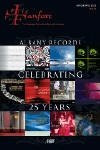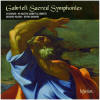Texte paru dans: / Appeared in:

Fanfare Magazine: 36:4 (03-04/2013)
Pour
s'abonner / Subscription information
Les abonnés à Fanfare Magazine ont accès aux archives du
magazine sur internet.
Subscribers to Fanfare Magazine have access to the archives of the magazine
on the net.
Hyperion
CDA67957

0034571179575 (ID268)
Consultez toutes les évaluations recensées pour ce cd
~~~~ Reach all the evaluations located for this CD
Giovanni Gabrieli (ca. 1554/7-1612) is enjoying the celebration of the quatercentenary of his death, but this is one of the few CDs that I have seen marking the anniversary. He occupied himself as organist of St. Mark’s Basilica for 28 years (from 1585), succeeding his uncle Andrea Gabrieli, who served from 1566. Neither of them, therefore, figures in the line of maestri da cappella of the basilica, even though they are renowned as composers for the liturgical celebrations there and Giovanni is regarded as the master of works for chori spezzati, the music for two or three choirs that would be placed in the galleries around the central crossing.
These 11 works are all taken from his two published collections, both titled Sacrae Symphoniae, of 1597 and (posthumously) of 1615. Aside from the much-recorded In ecclesiis à 14, I do not find the other 10 works duplicated much in my collection, which goes as far back as two early-stereo LPs on Vanguard. Only one instrumental work is included, the Canzon primi toni à 10, which is on the complete canzonas and sonatas of 1597 already recorded earlier by His Majestys Sagbutts and Cornetts and probably by others. A cursory check shows no listing for four of these selections and only one or two for most of the others, suggesting that an effort has been made to give us some of the lesser-known works in these two famous publications.
Jeffrey Skidmore and his vocal ensemble Ex Cathedra have joined with two ensembles of sackbuts and cornetts to realize Gabrieli’s vision of performers distributed around the altar of St. Mark’s. Exultet iam angelica turba requires 17 voices and Omnes gentes plaudite manibus calls for 16. The former is the first part of the long Easter Herald, normally sung solo at the Easter vigil. The work is set for 14 voices in the 1615 print, but three parts were later added in a manuscript now in Kassel. Everything on the program is set for at least eight voices except the unusual Kyrie, which uses five voices for the first invocation, eight for the second, and 12 for the final one. Unusually long is the Litany of the Blessed Virgin for eight voices. The performances are uniformly marked by restraint; it would be so easy to let out all the stops and raise the rafters, but Skidmore appreciates the musical integrity of the composer’s vision, notably in the Kyrie, which would seem to invite a huge climax as voices are added to each invocation. Not to be ungrateful for such a marvelous disc, but surround sound would make it even more glorious (not a format in this label’s arsenal, it would seem). This anniversary celebration is enthusiastically recommended to all would-be Venetians.
Cliquez l'un ou l'autre
bouton pour découvrir bien d'autres critiques de CD
Click either button for many other reviews


